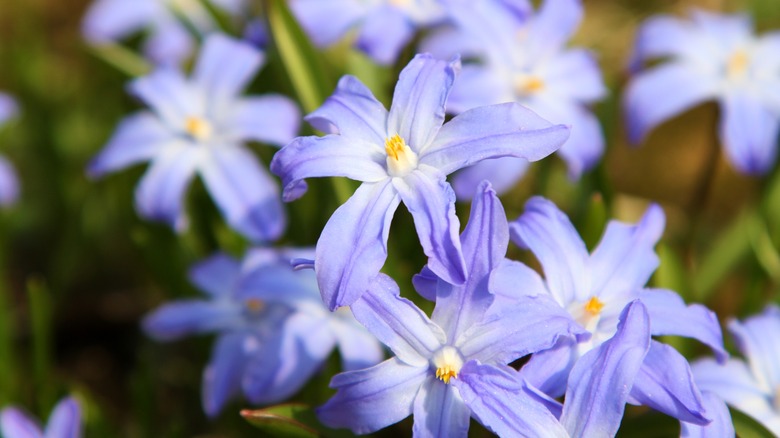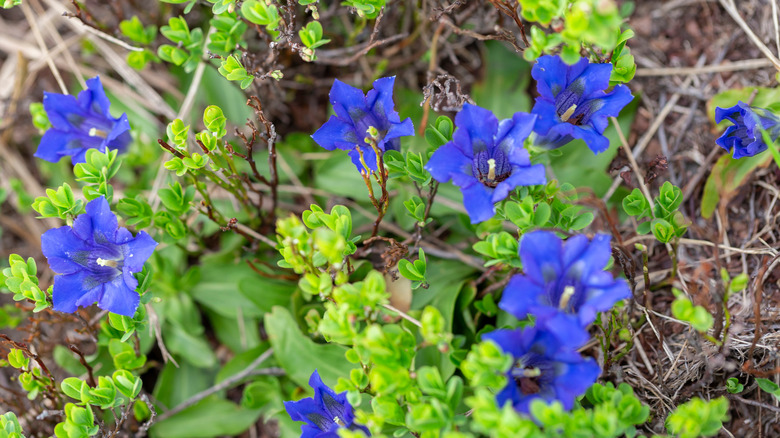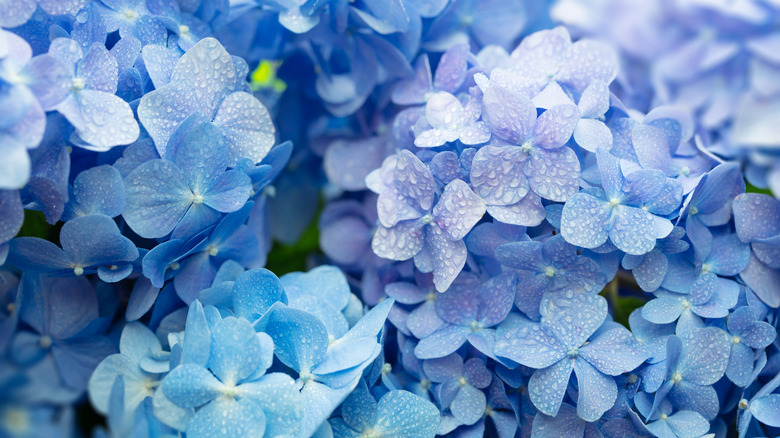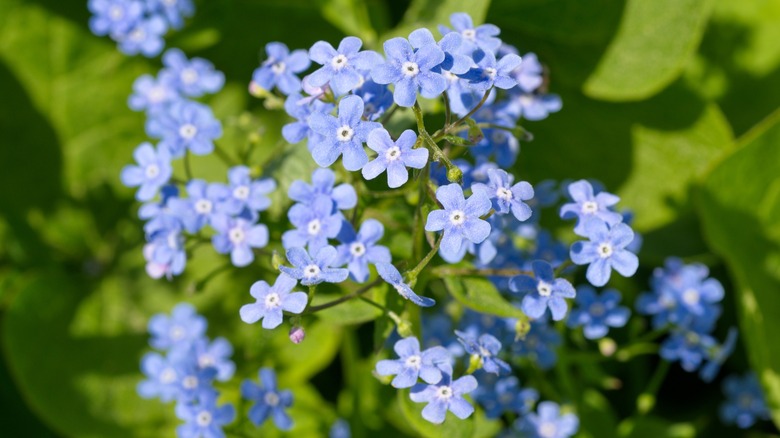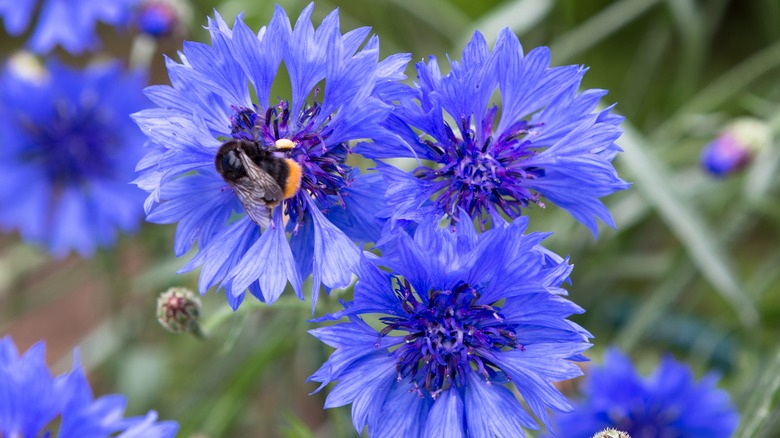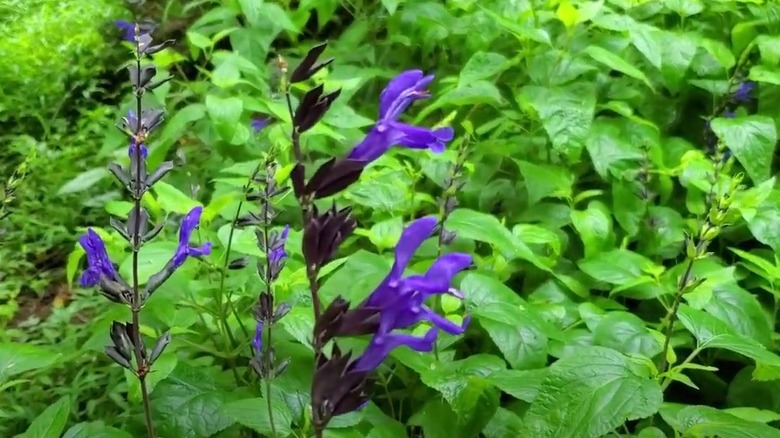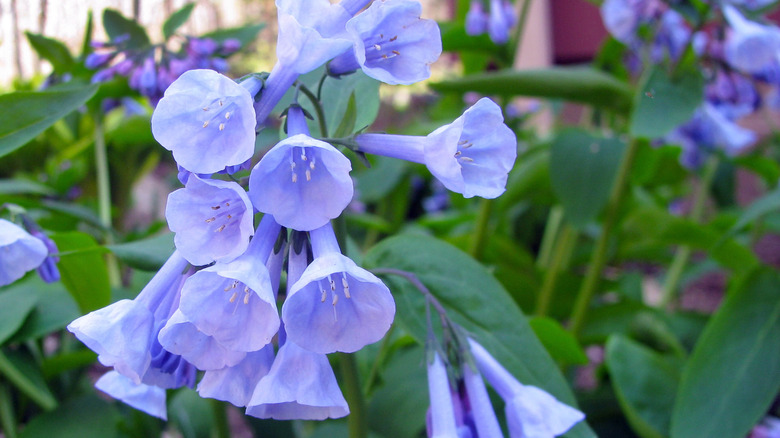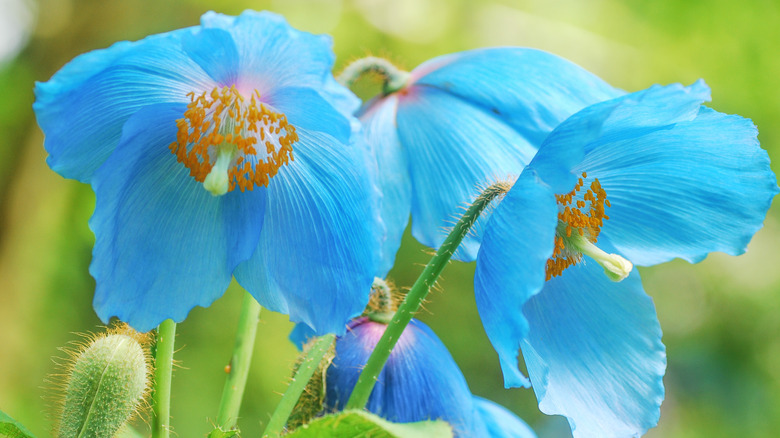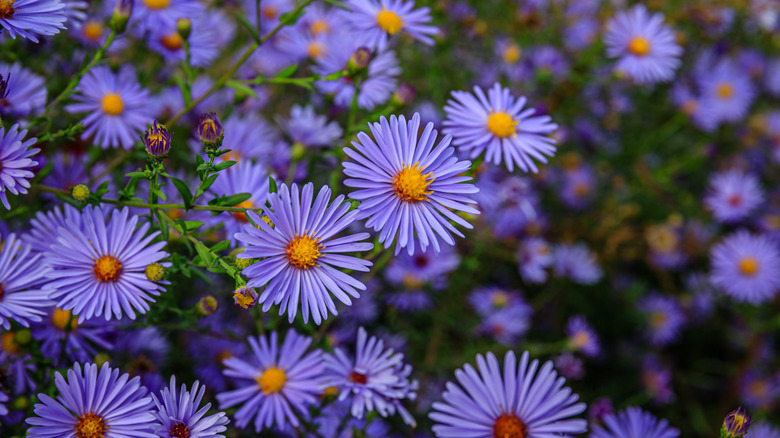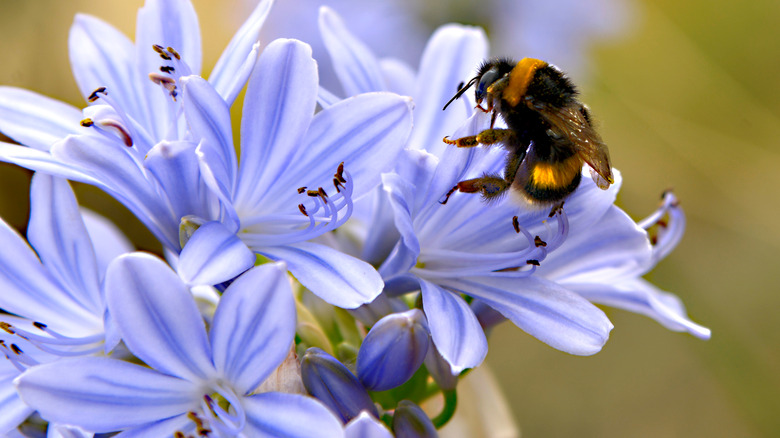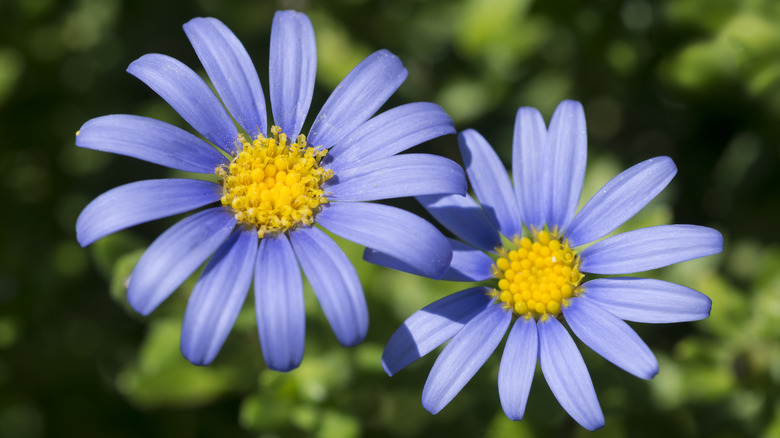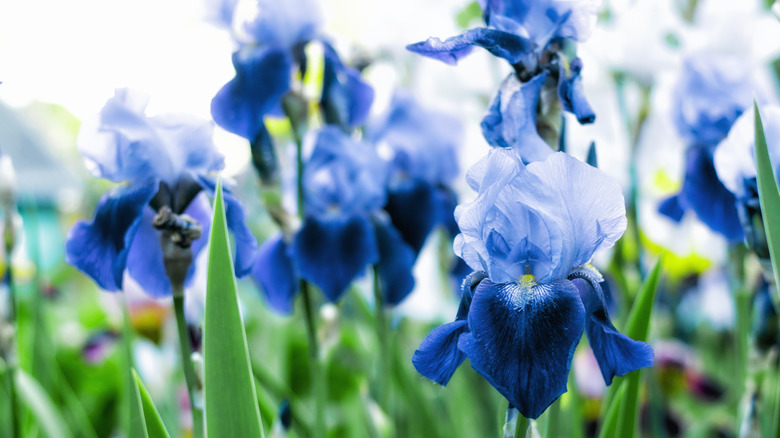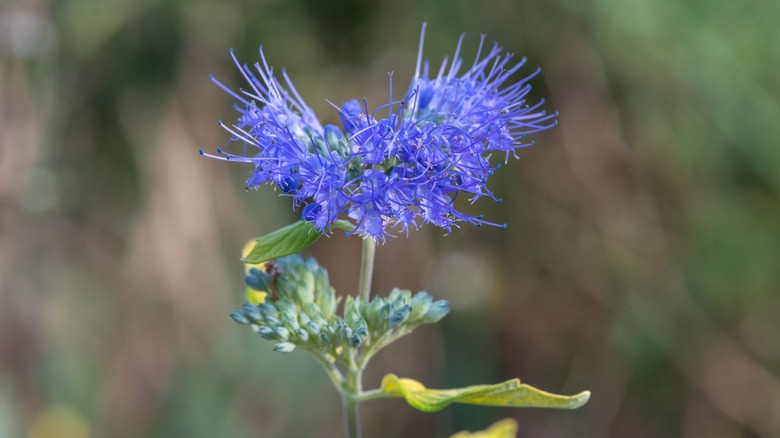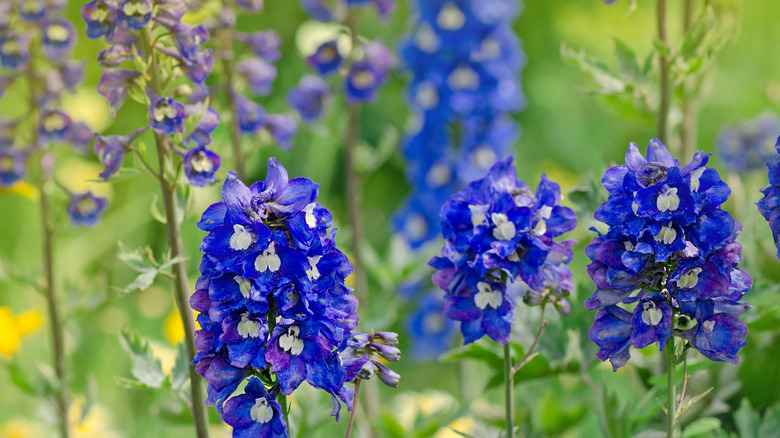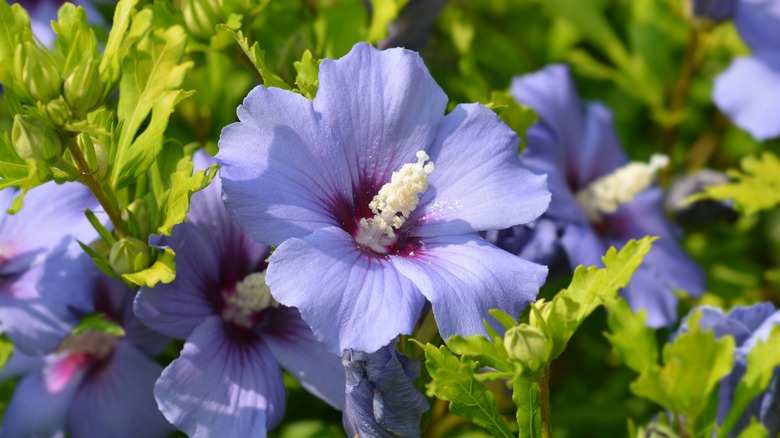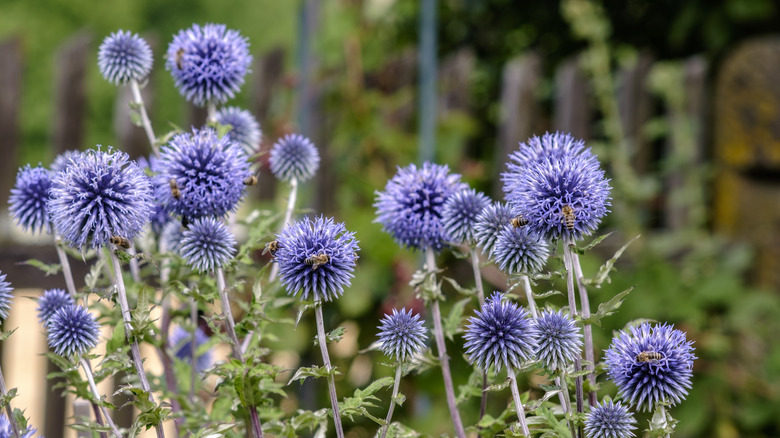15 Stunning Blue Flowers You Should Grow In Your Garden
When you think of a flower garden outside your home, what image comes to mind? Are wildflowers growing naturally throughout the yard? Or do you have neat planter boxes below your home's windows? Maybe you have planter beds in your backyard that create a contained chaos of blooms.
However you like your flowers to grow, finding the perfect plant to grow in your garden is half the fun. Flowers can add color to an otherwise monochrome backyard. They can attract pollinators like bees, birds, and butterflies.
Bright blue blooms are perfect to add a calming atmosphere to your landscaping, as, according to Verywell Mind, blue is a calm and serene color. According to Simplify Gardening, only 10% of all flowers are blue, making it one of the rarest to occur in nature. Despite their rarity, there are plenty of blue flowers to fill your garden with striking color. Choose as many of these fifteen blue blooms for your backyard as you'd like, and you'll soon have a tranquil oasis.
1. Gentian
Blooming a bright, vivid blue, gentian flowers are perennial plants found in many gardens. These flowers are native to mountainous areas but adapt well to landscaping. Gentian flowers most often have trumpet-shaped blooms and can grow to about 12 inches in height.
Gentian flowers grow best in zones 4 through 7 and bloom from midsummer into the early fall. They prefer full sun or partial shade. It's best to keep them out of the afternoon sun in areas with hot and humid summers. Plan these flowers in rich, well-draining soil, but keep the soil moist to avoid dried-out petals.
2. Hydrangea
Hydrangeas are everywhere during the summer. You'll often see them in people's yards or lining their property as flowering bushes. Hydrangeas come in many colors, including pink, purple, and white. There are also many varieties of hydrangeas, but the most common are the mophead with its circular cluster of tiny flowers. According to Gardener's Path, mopheads tend to be blue when the soil is more acidic and can turn pink in alkaline soil.
You'll see hydrangeas blooming from midsummer into the early fall. They grow best in USDA zones 5 to 9 and with full sun to partial shade. With the right conditions, they can grow as much as 4 feet tall and wide.
3. Brunnera
Brunnera are also known as a false forget-me-not because of the similarity in appearance. It has beautiful heart-shaped foliage and small clusters of light blue flowers. Maintaining soil moisture is the key to a thriving brunnera plant. Don't let the soil dry out, but don't allow it to become too soggy, says Gardening Know How. Rich and fertile soil with a pH of 5.5 to 7.0 is best.
They do best in USDA zones 3 through 8 and prefer shady backyards or even partial sun. With the right care, you'll see blooms appear between late April through June, and they can grow as tall as 15 inches.
4. Cornflower
Cornflowers have been a long favorite of gardeners for their vivid color and unique shape. If you're a gardener who likes to use their garden plants at the table, you'll be happy to know the cornflowers are edible and have a sweet cucumber-like taste, according to American Meadows.
They can grow to as much as 3 feet tall and 10 inches wide and have narrow, pointed petals that create a spikey appearance. Cornflowers reach peak bloom between early and mid-summer and are great for attracting butterflies and bees. These flowers will thrive in zones 2 through 11 with full sun and well-draining alkaline soil.
5. Black and blue sage
Featuring spikes of cobalt blue flowers, black and blue sage is the perfect accent for your garden flowers. According to North Carolina Extension Gardener Plant Toolbox, these flowers have a slight scent of anise, particularly when bruised. Black and blue sage is easy to care for, so it's best for low-maintenance gardeners. In areas where winters are warm, these plants are evergreen and can grow up to five feet tall.
They grow best in USDA zones 7 through 10 and prefer full or partial sun. You'll find them blooming from mid to late summer through the fall. They grow best in well-draining soil like loam or sand and can thrive in an acid, alkaline, or neutral pH.
6. Virginia bluebells
Don't be deceived when these flowers start out as bright pink bulbs. They mature into a delicate sky-blue color with a trumpet-like shape. According to Prairie Nursery, these flowers start appearing after the snow melts in early spring and bloom fully from April to May. They go dormant in the summer, but they're perennials.
Virginia bluebells are native to the eastern United States, so they're ideal for any gardener looking to add native wildflowers to attract pollinators. These flowers grow best in USDA zones 3 through 8, prefer filtered shade, and can reach heights of 18 inches. Add organic material like compost to a well-draining soil for best growth.
7. Blue poppy
A show-stopping addition to your garden, the Himalayan blue poppy features bright blue petals and a yellow center. These flowers are often rare sights in gardens, making them a must-have for the avid gardener. Blue poppies are difficult to grow because they need rich, well-draining soil and a good amount of fertilizer to allow them to thrive, says Rhododendron Species Botanical Garden. They can grow as tall as 5 feet with large blooms.
Blue poppies thrive best in USDA zones 3 and 9 and prefer partial shade and to be protected from strong winds. Enjoy these blooms from late spring through the early summer.
8. Aster
If you want to extend the blooms in your garden, plant aster. As other flowers begin fading in the later summer, aster continues to bloom and provide daisy-like flowers into the fall. There are many species native to North America, including the New England aster and the New York aster, says Alamanac.
Asters will thrive in USDA zones 5 through 9. With full sun and well-draining loam soil, asters will thrive. Clay soil can rot the roots, while sandy soil will dry them out. With all conditions met, asters can grow up to 18 inches tall and bloom from July into September.
9. Lily of the Nile
These compact blooms produce round flower clusters that have a gorgeous exotic look. Often called the African Lily, gardeners love this flower because it's easy to grow in most gardens. Lily of the Niles are also pest- and disease-free, says Gardenia.
To allow a Lily of the Nile to thrive, it's best to grow them in USDA zones 8 to 11 and watch them bloom between July and September, with the whole plant growing almost three feet tall and three feet wide. These flowers prefer fertile and well-draining soil. As for sunlight, they prefer between 6 to 8 hours of full sunlight each day. But if you live in a particularly hot climate, plant in partial shade.
10. Felicia daisy
Daisies are associated with happiness, and you can see why after seeing a field of Felicia daisies. These flowers feature yellow centers and sky-blue petals. This is an easy-to-grow plant that's heat tolerant. According to Plant Addicts, these flowers bloom from spring until the first frost in late fall. Deer don't like the taste, but pollinators do.
Mature Felicia daisies can grow up to 12 inches tall and spread out over five feet. USDA zones 10 and 11 are best, so they can get full sun to partial shade. Plant in a well-draining loam soil that will keep the flower from getting wet feet.
11. Iris
The iris may be one of the most famous blue flowers. It's often best known as the subject of one of Vincent Van Gogh's paintings. But gardeners have loved these ruffled blooms for decades. The most popular variety is the bearded iris, says Garden Design, which has white hairs at the center of the flower.
Irises grow best in USDA zones 5 through 9 and will bloom in the mid to late spring and then again in the summer. Give these flowers full sun and a fertile, slightly acidic, and well-draining soil to thrive, and they can grow up to 39 inches tall.
12. Bluebeard
Bluebeards are a shrub that blooms with clusters of dark blue flowers. According to Plant Addicts, bluebeard flowers attract butterflies and bees to a garden, so they're an ideal choice for a pollinator garden.
These are hardy plants that are easy to grow in USDA zones 5 through 9. Plant these in well-draining soil and give the flowers full sun or light shade. They'll bloom throughout the midsummer and fall and can grow up to 3 feet tall.
13. Delphinium
According to Almanac, the delphinium genus has over 300 species of flowers that include annuals, perennials, and biennials. You should handle them with care because they're highly poisonous. They may be best kept in places where animals cannot graze them. It's also recommended to wear gloves when handling to avoid skin irritation.
Delphiniums grow best in USDA zones 3 through 7 and will thrive in a well-draining and fertile soil while getting full sun to light shade. Thriving, they can grow up to 18 inches and produce showy blooms starting in early summer. Delphiniums don't like strong winds or rains, so be sure to shelter them during summer storms.
14. Rose of Sharon
The Rose of Sharon is a type of hibiscus that will give your garden a tropical touch. The blue chiffon variety provides a beautiful bluish-lavender shade. They're easy to grow and tolerant to most growing conditions, says Proven Winners. You can even find these flowers thriving in excess heat and humidity, droughts, and even poor soil.
Plant in zones 5 to 9 for the best results and expect to enjoy the blooms in early to late summer. They like full sun and aren't picky about their soil type, so choose any well-draining soil of any pH. With proper care, Rose of Sharon plants can grow up to 12 feet tall and 6 feet wide.
15. Globe Thistle
A truly unique flower, the globe thistle grows spike balls about the size of a golf ball. Their bold appearance will make a statement and add contrast to your garden. They're resilient against pests and diseases, says Gardenia, and they're resistant to deers and rabbits. They also attract bees or butterflies to your garden.
Plant globe thistle in full sun in USDA zones 4 through 9 for the best results. Globe thistles like full sun and well-draining soil that is consistently moist. The soil should have an acidic pH of about 5.5 to 7.0. They can grow up to 4 feet tall and bloom from late June into September.
